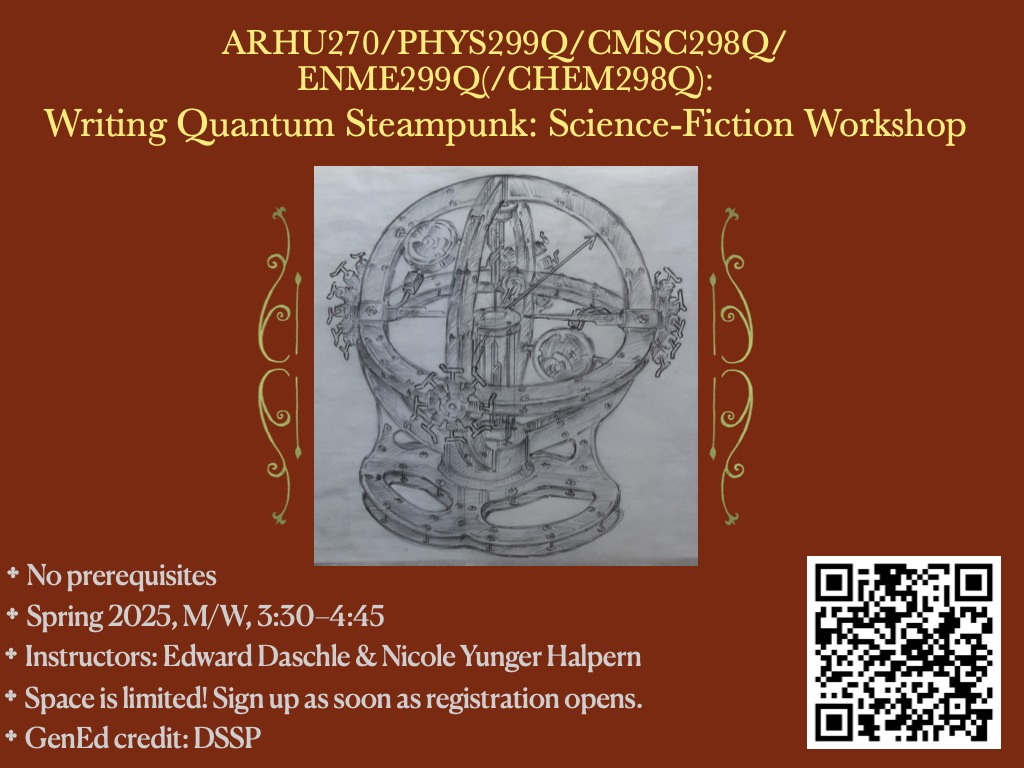Why not run a quantum-steampunk creative-writing course?
Quantum steampunk, as Quantum Frontiers regulars know, is the aesthetic and spirit of a growing scientific field. Steampunk is a subgenre of science fiction. In it, futuristic technologies invade Victorian-era settings: submarines, time machines, and clockwork octopodes populate La Belle Èpoque, a recently liberated Haiti, and Sherlock Holmes’s London. A similar invasion characterizes my research field, quantum thermodynamics: thermodynamics is the study of heat, work, temperature, and efficiency. The Industrial Revolution spurred the theory’s development during the 1800s. The theory’s original subject—nineteenth-century engines—were large, were massive, and contained enormous numbers of particles. Such engines obey the classical mechanics developed during the 1600s. Hence thermodynamics needs re-envisioning for quantum systems. To extend the theory’s laws and applications, quantum thermodynamicists use mathematical and experimental tools from quantum information science. Quantum information science is, in part, the understanding of quantum systems through how they store and process information. The toolkit is partially cutting-edge and partially futuristic, as full-scale quantum computers remain under construction. So applying quantum information to thermodynamics—quantum thermodynamics—strikes me as the real-world incarnation of steampunk.
But the thought of a quantum-steampunk creative-writing course had never occurred to me, and I hesitated over it. Quantum-steampunk blog posts, I could handle. A book, I could handle. Even a short-story contest, I’d handled. But a course? The idea yawned like the pitch-dark mouth of an unknown cavern in my imagination.
But the more I mulled over Edward Daschle’s suggestion, the more I warmed to it. Edward was completing a master’s degree in creative writing at the University of Maryland (UMD), specializing in science fiction. His mentor Emily Brandchaft Mitchell had sung his praises via email. In 2023, Emily had served as a judge for the Quantum-Steampunk Short-Story Contest. She works as a professor of English at UMD, writes fiction, and specializes in the study of genre. I reached out to her last spring about collaborating on a grant for quantum-inspired art, and she pointed to her protégé.
Who won me over. Edward and I are co-teaching “Writing Quantum Steampunk: Science-Fiction Workshop” during spring 2025.
The course will alternate between science and science fiction. Under Edward’s direction, we’ll read and discuss published fiction. We’ll also learn about what genres are and how they come to be. Students will try out writing styles by composing short stories themselves. Everyone will provide feedback about each other’s writing: what works, what’s confusing, and opportunities for improvement.
The published fiction chosen will mirror the scientific subjects we’ll cover: quantum physics; quantum technologies; and thermodynamics, including quantum thermodynamics. I’ll lead this part of the course. The scientific studies will interleave with the story reading, writing, and workshopping. Students will learn about the science behind the science fiction while contributing to the growing subgenre of quantum steampunk.
We aim to attract students from across campus: physics, English, the Jiménez-Porter Writers’ House, computer science, mathematics, and engineering—plus any other departments whose students have curiosity and creativity to spare. The course already has four cross-listings—Arts and Humanities 270, Physics 299Q, Computer Science 298Q, and Mechanical Engineering 299Q—and will probably acquire a fifth (Chemistry 298Q). You can earn a Distributive Studies: Scholarship in Practice (DSSP) General Education requirement, and undergraduate and graduate students are welcome. QuICS—the Joint Center for Quantum Information and Computer Science, my home base—is paying Edward’s salary through a seed grant. Ross Angelella, the director of the Writers’ House, arranged logistics and doused us with enthusiasm. I’m proud of how organizations across the university are uniting to support the course.
The diversity we seek, though, poses a challenge. The course lacks prerequisites, so I’ll need to teach at a level comprehensible to the non-science students. I’d enjoy doing so, but I’m concerned about boring the science students. Ideally, the science students will help me teach, while the non-science students will challenge us with foundational questions that force us to rethink basic concepts. Also, I hope that non-science students will galvanize discussions about ethical and sociological implications of quantum technologies. But how can one ensure that conversation will flow?
This summer, Edward and I traded candidate stories for the syllabus. Based on his suggestions, I recommend touring science fiction under an expert’s guidance. I enjoyed, for a few hours each weekend, sinking into the worlds of Ted Chiang, Ursula K. LeGuinn, N. K. Jemison, Ken Liu, and others. My scientific background informed my reading more than I’d expected. Some authors, I could tell, had researched their subjects thoroughly. When they transitioned from science into fiction, I trusted and followed them. Other authors tossed jargon into their writing but evidenced a lack of deep understanding. One author nailed technical details about quantum computation, initially impressing me, but missed the big picture: his conflict hinged on a misunderstanding about entanglement. I see all these stories as affording opportunities for learning and teaching, in different ways.
Students can begin registering for “Writing Quantum Steampunk: Science-Fiction Workshop” on October 24. We can offer only 15 seats, due to Writers’ House standards, so secure yours as soon as you can. Part of me still wonders how the Hilbert space I came to be co-teaching a quantum-steampunk creative-writing course.1 But I look forward to reading with you next spring!
1A Hilbert space is a mathematical object that represents a quantum system. But you needn’t know that to succeed in the course.


Pingback: Sculpting quantum steampunk | Quantum Frontiers